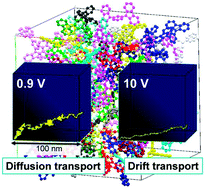Multiscale simulation of charge transport in a host material, N,N′-dicarbazole-3,5-benzene (mCP), for organic light-emitting diodes†
Abstract
We have performed multiscale charge transport simulations in organic amorphous thin films by explicitly considering organic molecules. The simulations were based on quantum chemical and Monte Carlo calculations. The amorphous layer was composed of N,N′-dicarbazole-3,5-benzene, which is a widely used host material in the emissive layer of blue-emitting organic light-emitting diodes. The hole mobility was calculated to be three to four times larger than the electron mobility. This trend was consistent with the experimentally obtained mobility ratio. It was also found that the charges are transported dominantly by a diffusion-type character at low applied electric fields and the contribution of the drift-type character increases as the applied electric field is increased. The difference between the number of hops in the forward and the backward directions contributes to the actual charge transport. From the detailed molecular level analysis, it was turned out that the molecular pairs with a large electronic coupling do not necessarily have large contributions to the charge transport, rather they can temporarily trap charges. We found important molecular pairs, which form effective charge-transfer paths, although the electronic coupling was not substantially large.


 Please wait while we load your content...
Please wait while we load your content...